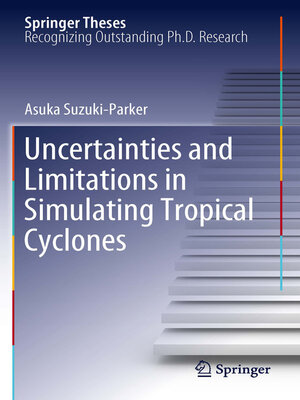Uncertainties and Limitations in Simulating Tropical Cyclones
ebook ∣ Springer Theses
By Asuka Suzuki-Parker

Sign up to save your library
With an OverDrive account, you can save your favorite libraries for at-a-glance information about availability. Find out more about OverDrive accounts.
Find this title in Libby, the library reading app by OverDrive.



Search for a digital library with this title
Title found at these libraries:
| Library Name | Distance |
|---|---|
| Loading... |
The thesis work was in two major parts: development and testing of a new approach to detecting and
tracking tropical cyclones in climate models; and application of an extreme value statistical approach to
enable assessment of changes in weather extremes from climate models.
The tracking algorithm applied a creative phase-space approach to differentiate between modeled tropical
cyclones and their mid-latitude cousins. A feature here was the careful attention to sensitivity to choice of
selection parameters, which is considerable. The major finding was that the changes over time were
relatively insensitive to these details. This new approach will improve and add confidence to future
assessments of climate impacts on hurricanes.
The extremes approach utilized the Generalized Pareto Distribution (one of the standard approaches to
statistics of extremes) applied to present and future hurricane distributions as modeled by a regional
climate model, then applied the changes to current observations to extract the changes in the extremes.
Since climate models cannot resolve these extremes directly, this provides an excellent method of
determining weather extremes in general. This is of considerable societal importance as we are most
vulnerable to such extremes and knowledge of their changes enables improved planning and adaptation
strategies.
tracking tropical cyclones in climate models; and application of an extreme value statistical approach to
enable assessment of changes in weather extremes from climate models.
The tracking algorithm applied a creative phase-space approach to differentiate between modeled tropical
cyclones and their mid-latitude cousins. A feature here was the careful attention to sensitivity to choice of
selection parameters, which is considerable. The major finding was that the changes over time were
relatively insensitive to these details. This new approach will improve and add confidence to future
assessments of climate impacts on hurricanes.
The extremes approach utilized the Generalized Pareto Distribution (one of the standard approaches to
statistics of extremes) applied to present and future hurricane distributions as modeled by a regional
climate model, then applied the changes to current observations to extract the changes in the extremes.
Since climate models cannot resolve these extremes directly, this provides an excellent method of
determining weather extremes in general. This is of considerable societal importance as we are most
vulnerable to such extremes and knowledge of their changes enables improved planning and adaptation
strategies.







